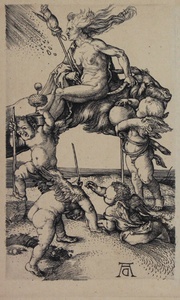| Method | Héliogravure |
| Artist | Charles Amand-Durand after Albrecht Dürer |
| Published | Paris. Amand-Durand. 69, Rue du Cardinal-Lemoine 69 [c.1870] |
| Dimensions | Image 115 x 70 mm, Sheet 128 x 78 mm |
| Notes |
Durer's 'Witch Riding Backwards on a Goat' was issued around 1500, at the height of the European witch panic. This heliogravure after Durer's etching shows a naked elderly woman holding aloft a broom or rag-topped wand, a look of malice on her face as she calls down rain and hail. She rides a shaggy long-horned goat, either her familiar or the devil himself. She is accompanied by a quartet of winged putti, who cavort in a circle before her. One carries a potted plant, potentially one of the earliest depictions of thorn-apple in western art. Thorn-apple, or datura, was introduced to Europe from the New World, rapidly becoming a part of traditional folk medicine, but equally a favourite tool of the poisoner. Another holds aloft a spherical pot, possibly an alchemist's aludel. Like others before him, Charles Armand-Durand attempted to democratise the art industry by reproducing the works of famed artists which were hidden from the general public in the repositories of the French National Library, or in the ownership of private collectors. His main series of facsimiles after Old Master prints began in 1869. They were usually published in portfolios, with accompanying text by Georges Duplessis. In order to create a héliogravure, a high quality photograph would have been taken of Dürer's original work. The negative would then be exposed onto a gelatin covered copper plate, and etched with acid. At this point, the photogravure would have been mechanically printed, but the technique of the héliogravure differs. Amand-Durand etched parts of the plate himself, and printed the works by hand. Somewhat paradoxically, Amand-Durand's works have become as esoteric as the artists that he sought to democratise. Charles Amand-Durand (1831 - 1905) was a French printmaker and publisher. He is best remembered as the pioneer of the héliogravure. Together with Georges Duplessis, he produced portfolios replicating the work of artists such as Dürer, Rembrandt, Claude and Lucas van Leyden. As with other publishers of the time, he printed his works on antiquated paper, so as to give the impression of the original. His works can however be identified by the red stamp which bears his initials on the verso. Albrecht Dürer (1471 - 1528) was a celebrated German polymath. Though primarily a painter, printmaker and graphic artist, he was also a writer, mathematician and theoretician. Born in Nuremberg, Dürer was apprenticed to the painter Michel Wolgemut whose workshop produced woodcut illustrations for major books and publications. He travelled widely between the years of 1492 and 1494, and is known to have visited Martin Schongauer, the leading German painter and engraver at the time, at his studio in Colmar. In 1495, Dürer set up his own workshop in his native Nuremberg, and, by the beginning of the sixteenth-century, had already published three of his most famous series' of woodcuts: The Apocalypse, The Large Passion, and The Life of the Virgin. Nuremberg was something of a hub for Humanism at this time, and Dürer was privy to the teachings of Philipp Melanchthon, Willibald Pirkheimer and Desiderius Erasmus. The latter went so far as to call Dürer 'the Apelles of black lines', a reference to the most famous ancient Greek artist. Though Dürer's approach to Protestantism was not as staunch as that of his fraternity, his artwork was just as revolutionary. For their technical virtuosity, intellectual scope, and psychological depth, Dürer's works were unmatched by earlier printed work, and, arguably, have yet to be equalled. Condition: Amand-Durand red stamp on verso. |
| Framing | unmounted |
| Price | £350.00 |
| Stock ID | 46221 |

